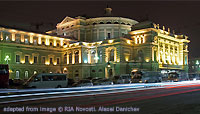Putin Opens $700 Million New Mariinsky With Domingo Gala

(Bloomberg – bloomberg.com – Henry Meyer & Stepan Kravchenko – May 3, 2013) President Vladimir Putin and performers led by Placido Domingo starred at the opening of a $700 million stage for the Mariinsky Theatre that aims to cement its status as one of the world’s top cultural institutions.
Last night’s black-tie gala starts three days of celebrations in St. Petersburg, Russia’s former imperial capital. The 230-year-old company’s state-funded expansion is “the most exciting new chapter” since the 1917 Revolution, Mariinsky’s director Valery Gergiev told Bloomberg News before conducting the opening night.
Putin, speaking to the champagne-drinking, jewel-wearing crowd, praised the theater. “It has always been and stays as one of the flagships of Russian culture,” he said. Domingo joined Russian-born soprano Anna Netrebko and German bass Rene Pape for scenes from Mozart’s “Don Giovanni.”
The opera house designed by Canadian architect Jack Diamond is connected via a bridge to the pale-green Mariinsky building that opened in 1860. It has stirred a storm of criticism in Putin’s hometown for a facade that some have compared to that of a shopping mall or office block.
Yet under the Russian leader’s personal patronage, Mariinsky II is part of the country’s global ambitions. The first opera house in Russia to be built on the scale of New York’s Lincoln Center, it allows the Mariinsky to simultaneously stage ballet, opera and orchestral performances. Putin has just bestowed on Gergiev a Hero of Labor award, restored from the Soviet era, for his contribution to the arts.
Cultural Crown
“It is setting up St. Petersburg to be the jewel in the world’s cultural crown,” said Graham Watts, head of the dance section of the U.K. Critics’ Circle, who met Gergiev in December during a presentation in London of the project.
The Mariinsky, known in Soviet times as the Kirov, won the Critics Circle’s 2011 outstanding dance company prize.
“Gergiev’s domination at the Mariinsky, which is strong and rooted in a creative vision, means that you have a clear-sighted company that doesn’t have these divisions and political problems that the Bolshoi has,” Watts said in a phone interview.
Domingo, who also performed a solo scene from Wagner’s “Die Walkure,” said afterward that the concert had been “phenomenal in this fantastic opera house.”
Opera Love
“It’s amazing that it’s happening in this city which in the old days was as important as Paris,” he told Bloomberg. “That’s amazing that the Russian public can really have the love for opera now having two theaters” including the restored Bolshoi, Domingo said.
The Kremlin-blessed project has scarred the city landscape in St. Petersburg, critics say. The exterior, made of limestone and no higher than nearby buildings, is characterless, they say.
“A lot of people don’t like it,” Mikhail Piotrovsky, director of the State Hermitage Museum, said on Saint Petersburg TV channel in February. “It’s absolutely uninspiring.”
Born in Moscow, Gergiev established a reputation after a Soviet classical musical education. He has led the Mariinsky for 17 years and conducted its orchestra since 1988. He is also the chief conductor of the London Symphony Orchestra. In January he was named chief conductor of the Munich Philharmonic Orchestra for a five-year term beginning in 2015.
Putin was re-elected to a third term last year following unprecedented protests against his 13-year-rule. Gergiev was among some 500 people who campaigned for him in the presidential election, according to state news service RIA Novosti.
Gergiev’s Birthday
Putin’s role “is all-important because he as a president made it possible for people like myself” to enact their visions, Gergiev said yesterday as he prepared for the opening night, coinciding with his 60th birthday.
Diamond is the third architect on the project. The first was California-based Eric Moss, whose crumpled-glass facade was rejected in 2002 as too much of a departure from local design.
In 2003, a competition jury picked France’s Dominique Perrault, architect of the French National Library. His plan for a domelike structure in golden glass was scrapped in 2007.
“It was a very interesting project that created something new,” said Piotrovsky, a jury member who voted for Perrault.
The French design was “beautiful but unrealistic,” according to Gergiev.
An architectural preservation group called Beautiful Petersburg conducted a survey among 1,300 residents this year. More than 90 percent said the Diamond building looked nothing like a theater. Activists called for it to be razed.
Monumental Art
“People had been hoping for something theatrical and dramatic,” said James S. Russell, Bloomberg Muse’s architecture critic. “Opera is a monumental art form and to have something that dampens down enthusiasm before you enter isn’t ideal.”
Gergiev hired Diamond after meeting him in Toronto in 2007. He was impressed with the city’s Four Seasons Center for the Performing Arts, which is renowned for its acoustics.
Mariinsky II’s 80,000 square meter (852,000 square foot) facilities include an auditorium that can seat 2,000 spectators, rehearsal rooms for chorus, ballet and orchestra as well as production areas.
Built with Swedish-like simplicity in wood and plaster, its seats are computer-designed to ensure full views from every angle. Bay windows offer a vista of the old Mariinsky. The exterior of the auditorium is encased in amber-colored onyx.
“Just as the church or cathedral is the holy of holies of the faith, so the auditorium of the Mariinsky is the holy of holies of music,” Diamond said in an interview. “The public areas is where the fun begins, not on the outside but on the inside.”
Kommersant, one of Russia’s leading newspapers, gave the new Mariinsky a cautious thumbs-up, saying: “The facade didn’t turn out too well but as far as theater is concerned, there simply isn’t a better place to stage opera in Russia.”
The opening comes as the Bolshoi in Moscow is mired in scandal after an acid attack on its artistic director Sergei Filin revealed his battle to modernize the institution founded in 1776.
